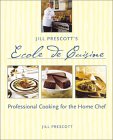|
A Thinking Man's Escoffier
Think Like a Chef
Jill Prescott's Ecole de Cuisine:
My most recent experience of such an antiseptic intimacy was eleven months ago. The physician had doffed his rubber gloves and was making notes in my chart when I was overcome by the need to speak in the worst way. Which was, of course, precisely how I went about it. "You have a ... er ... um ... it's a difficult job, eh?" He greeted my embarrassed and witless stammering at first with a furrowed brow, then, to my relief, smiled. "You can't imagine the half of it," he responded in comradely fashion. It was as if he were speaking with a colleague on grand rounds, casually sharing the observation that, yes, medicine would be ever so nice a profession if only we didn't have to deal with ... well, with patients. "My oath constrains me to do the very same to men I wouldn't shake hands with socially." All of which introduces the sub-text of this ramble, the difference between professional chefs and civilians. If I may be allowed a dollop ibutoetic license, it seems to me that the men and women who bake their bread to make their bread are the gastronomical analogs of internal examiners--folks willing to cook their little hearts out for people they have never shaken hands with and probably would not like if they did. So how, then, does a socially avid advanced hobby cook assume the mantle of a latter-day Careme? Well, present opinion is mixed. Prescott, founder and principal of Ecole de Cuisine and public television personality, says it's a matter of basic technique and repetitive practice. "If it works," she counsels in a sentence that places this Kohler, Wisconsin schoolmarm in imminent danger of being arrested for impersonating an author, "don't fix it." Colicchio, meanwhile, a James Beard/American Express Best Chef Award winner and partner in New York's Gramercy Tavern, argues that to think like a chef home cooks need to be able to walk through a market without a recipe, understand the potential of the ingredients they select, and use a few time-honored techniques and solid skills to whip them into never-seen-before preparations that are as seamless on the plate as a French kiss. Of the two, Colicchio makes the more compelling case for those who know their way around a Vulcan, though Prescott's if-at-first-you-don't-fricassee-fry-fry-a-hen mentality is not to be dismissed either entirely or even lightly. Cookbooks, like most how-to titles, are nearly impossible to judge in absolute terms. Fairness calls for evaluation in light of the needs of the audience for whom they are written. By this calculus, Prescott's inappropriately titled work amounts to a Green Card marriage--basic French technique and American tenacity--for those whose CQ (cooking quotient) might approach but not exceed their glove size. In eleven run-Spot-run lessons that range from kinderkitchen basics (how to boil water) to post-doctoral colloquies (tempering chocolate), she lays out what beginners need to know. If you can excuse the writing, pardon the graphics, forgive the typography, and put aside the burning question of why disposable cameras can't be made with better lenses, here is useful information and solid but unadventurous recipes, e.g., penne alla puttanesca and steak au poivre, that might actually have you, if not looking forward to, then at least not dreading, your next Cousins' Club dinner (provided your cousins get the book in time). So much for the appetizer of Prescott. Now to the meat and potatoes of Colicchio, whose aptly-titled and seminal book is original, well written, beautifully presented, and, best of all, provocative of thoughtful exploration and regular use. In his successful effort to reveal the ways in which an accomplished professional finds the inspiration to create a dish, Colicchio proves himself a thinking man's Escoffier. Just as I marvel at what Titian, Rembrandt, and Van Gogh could do with the same spectrum available to everyone else, so I am struck by what the gifted Tom creates from ingredients as available in my markets as in his. For instance, I often use caul fat to create crepinettes and bard birds, but never wrapped striped bass stuffed with roasted tomatoes to produce his plush sea fare. In opening sections on ingredients and technique, Colicchio speaks to the attributes of foods and how they can be altered and intensified by other foods and methods. The recipes that follow ... including spiced roasted lobster with pea ravioli, braised duck with apples, pan-roasted asparagus, eggplant "napoleon," corn and potato pancakes with caviar, creamless creamed corn, and caramelized tomato tarts--come with extensive discussion of why he chooses a particular pairing of ingredients or specifies roasting instead of, say, braising. His goal is to provide readers with the discipline of understanding that, in the end, liberates creativity. The added value of the work is not the hundred or so luscious recipes per se but, rather, in the paradigmatic quality of these. They give you guidance you can rely on and follow to create your own permutations. So, which book has your name on it? Neither offers wine matches. If you or a friend are new to cookery, or if lectures are your metier, by all means pick up a copy of Prescott. But if what you seek is an explication of flavor and how it is built, layer upon layer, to produce achingly rich and mellow dining experiences, Tom's work is about as probing as it gets. Which reminds me. I need to make a call. It's nearly that time again. April 2001
|

